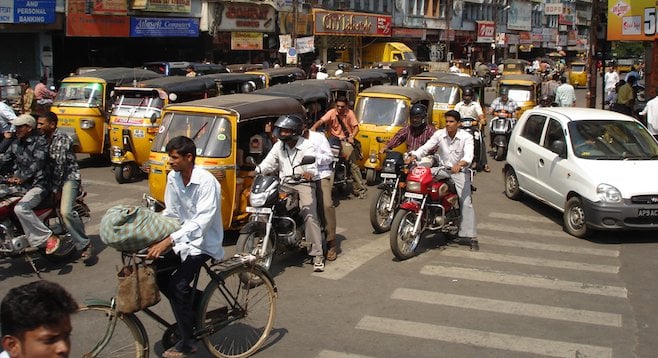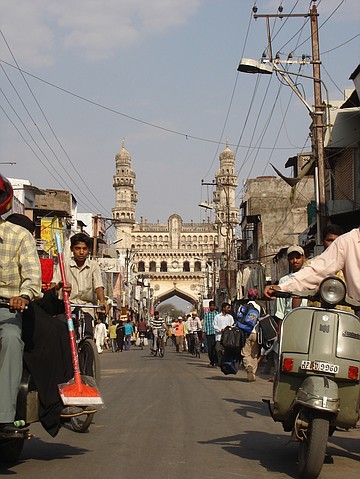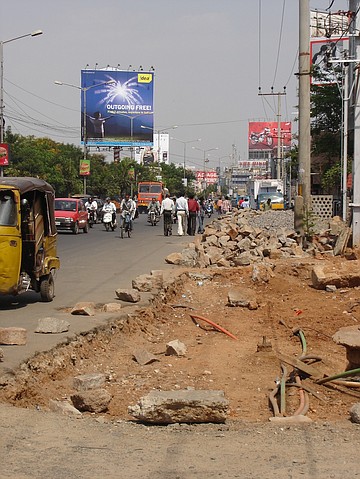 Facebook
Facebook
 X
X
 Instagram
Instagram
 TikTok
TikTok
 Youtube
Youtube

As much as we see globalization happening on every continent, I have seen a place as-of-yet unaffected.
Hyderabad, India, has yet to be conquered by McDonalds, Wal-Mart or Starbucks. You won't find much tourism there either. The stereotypical pale color of your Western skin makes you a walking target to all locals who walk the piles of rubble and dirt called streets. This is not a place for a pleasure tour.

Hyderabad is a place where sidewalks are for debris, not pedestrians; where streets are for dangerously commingling and commuting pedestrians, cars, trucks, busses, tractors and farm animals; where rivers of rickshaws buzz by, narrowly missing anything in their path as they fight for first in line. All forms of transportation carry well more than safe capacity as men, women, children and various body parts hang precariously out doors and windows – and off motorcycles whizzing by fully loaded with five passengers squeezed onto a banana seat.
The steady symphony of horn-honking eliminates any use of a radio. Forget about that morning coffee or tea. Just wrap yourself in a vibrant-colored cotton sari, slap on some flip-flops and take that open-toed trip to the office, dodging oncoming traffic. You’ll have all the adrenaline needed to get you through at least the first half of your workday.
Well actually, it’s more like work night. The next time you call that toll-free number when you have a computer problem that sends you to a guy with a strong Indian accent named “Joe,” you’ll know how he got to work for his night shift in a stark room full of muted cubicles.
It’s noon your time, but it’s midnight his time. Wearing a headset, planted in front of a computer, he represents the intense IT outsourcing being utilized by major American and global corporations alike. Those workers make one-eighth of what call center employees would make in the U.S., and they’re just grateful to have a job – despite any ramifications due to the anti-social work schedule that goes against the nature of one’s ingrained body clock.

In fact, this city is growing so rapidly, with more of its resources being tapped by global entities, that it looks like a war just ended. There are quite literally endless piles of rubble and dirt lining all (and I do mean all) the streets on both sides, making way for brand new rebar-and-cement-framed buildings going up absolutely everywhere in every direction. Their growth appears unsustainable and unorganized because there is no infrastructure in place to support and manage the virtually sudden boom.
It’s a Third-World country in the truest sense – corruption, massive poverty, clashes of classes – with a culture centuries old and a population four times that of the U.S. with half the land mass.
Imagine that for a moment. Hyderabad is like multiplying the population of the U.S. by four and plopping all those people in an area like Tijuana, Mexico, to fend for themselves. Quite frankly, Tijuana is luxury compared to this place.
And it’s HOT. Skin-melting, mouth-drying hot. The people all over the city digging holes and lifting boulders on construction sites have towels wrapped around their heads. There is no shade unless you’re under one of the massive and abundant technology billboards plastered all over the city. And construction work isn’t reserved for men. Women dressed in everyday wraps and flip-flops, with their specially formed hard hats that support a metal tray of rocks, walk hands-free from one rock pile to another, making hard labor look graceful.
As you travel along the main thoroughfare, there is no indication of a separation of classes. There are decorative mansions lining the streets where just outside their doorsteps, literally, are shanty towns where people bathe out of buckets and live in tents built out of tarps and sticks or in shelters of corrugated tin, all on top of dirt foundations in empty lots. The dichotomy of it all is mind-numbing.
There are also groups of people there referred to as “untouchables.” These human beings stand, sit or lay on the streets with their tattered, worn hands extended, hoping for generosity but being ignored by the millions passing by. What sets these people apart from the homeless we know in the States is the fact that many of them are disfigured – skin where eyes should be, missing arms and legs, distorted feet. I learned that when children of untouchables are born, some parents disfigure them on purpose so they have a way to make money in the future.
I was distraught by the scene... depressed, uncomfortable. I felt guilty for having the shoes on my feet, the clothes on my back. I wanted to give money – a dollar to me is 10 dollars to them. They say not to do that because every time I did, I wound up surrounded by tens of ever persistent people wanting a piece of the action - touching me, pulling on me, overwhelming me. I’d escape, scared, to the safety of my traveling companions for protection like a coward. One needs time to acclimate to this environment. I needed more time.
Hyderabad elicits confusion. It creates feelings that are difficult to process. Their culture is both Hindu and Muslim, who don't usually intermingle in the rest of the world. They are a people of smiles and tribulations. Their growth is enormous yet chaotic. Their classes are very rich or very poor while living next door to each other. They're modern with the utilization of technology, yet completely traditional with almost all women wearing saris and herds of goats, cows, chickens or buffalo wandering the roadsides. There is an energy here that is unmistakable, a drive to survive, an anthill of human beings – and there is by far no other place like it in the world.


As much as we see globalization happening on every continent, I have seen a place as-of-yet unaffected.
Hyderabad, India, has yet to be conquered by McDonalds, Wal-Mart or Starbucks. You won't find much tourism there either. The stereotypical pale color of your Western skin makes you a walking target to all locals who walk the piles of rubble and dirt called streets. This is not a place for a pleasure tour.

Hyderabad is a place where sidewalks are for debris, not pedestrians; where streets are for dangerously commingling and commuting pedestrians, cars, trucks, busses, tractors and farm animals; where rivers of rickshaws buzz by, narrowly missing anything in their path as they fight for first in line. All forms of transportation carry well more than safe capacity as men, women, children and various body parts hang precariously out doors and windows – and off motorcycles whizzing by fully loaded with five passengers squeezed onto a banana seat.
The steady symphony of horn-honking eliminates any use of a radio. Forget about that morning coffee or tea. Just wrap yourself in a vibrant-colored cotton sari, slap on some flip-flops and take that open-toed trip to the office, dodging oncoming traffic. You’ll have all the adrenaline needed to get you through at least the first half of your workday.
Well actually, it’s more like work night. The next time you call that toll-free number when you have a computer problem that sends you to a guy with a strong Indian accent named “Joe,” you’ll know how he got to work for his night shift in a stark room full of muted cubicles.
It’s noon your time, but it’s midnight his time. Wearing a headset, planted in front of a computer, he represents the intense IT outsourcing being utilized by major American and global corporations alike. Those workers make one-eighth of what call center employees would make in the U.S., and they’re just grateful to have a job – despite any ramifications due to the anti-social work schedule that goes against the nature of one’s ingrained body clock.

In fact, this city is growing so rapidly, with more of its resources being tapped by global entities, that it looks like a war just ended. There are quite literally endless piles of rubble and dirt lining all (and I do mean all) the streets on both sides, making way for brand new rebar-and-cement-framed buildings going up absolutely everywhere in every direction. Their growth appears unsustainable and unorganized because there is no infrastructure in place to support and manage the virtually sudden boom.
It’s a Third-World country in the truest sense – corruption, massive poverty, clashes of classes – with a culture centuries old and a population four times that of the U.S. with half the land mass.
Imagine that for a moment. Hyderabad is like multiplying the population of the U.S. by four and plopping all those people in an area like Tijuana, Mexico, to fend for themselves. Quite frankly, Tijuana is luxury compared to this place.
And it’s HOT. Skin-melting, mouth-drying hot. The people all over the city digging holes and lifting boulders on construction sites have towels wrapped around their heads. There is no shade unless you’re under one of the massive and abundant technology billboards plastered all over the city. And construction work isn’t reserved for men. Women dressed in everyday wraps and flip-flops, with their specially formed hard hats that support a metal tray of rocks, walk hands-free from one rock pile to another, making hard labor look graceful.
As you travel along the main thoroughfare, there is no indication of a separation of classes. There are decorative mansions lining the streets where just outside their doorsteps, literally, are shanty towns where people bathe out of buckets and live in tents built out of tarps and sticks or in shelters of corrugated tin, all on top of dirt foundations in empty lots. The dichotomy of it all is mind-numbing.
There are also groups of people there referred to as “untouchables.” These human beings stand, sit or lay on the streets with their tattered, worn hands extended, hoping for generosity but being ignored by the millions passing by. What sets these people apart from the homeless we know in the States is the fact that many of them are disfigured – skin where eyes should be, missing arms and legs, distorted feet. I learned that when children of untouchables are born, some parents disfigure them on purpose so they have a way to make money in the future.
I was distraught by the scene... depressed, uncomfortable. I felt guilty for having the shoes on my feet, the clothes on my back. I wanted to give money – a dollar to me is 10 dollars to them. They say not to do that because every time I did, I wound up surrounded by tens of ever persistent people wanting a piece of the action - touching me, pulling on me, overwhelming me. I’d escape, scared, to the safety of my traveling companions for protection like a coward. One needs time to acclimate to this environment. I needed more time.
Hyderabad elicits confusion. It creates feelings that are difficult to process. Their culture is both Hindu and Muslim, who don't usually intermingle in the rest of the world. They are a people of smiles and tribulations. Their growth is enormous yet chaotic. Their classes are very rich or very poor while living next door to each other. They're modern with the utilization of technology, yet completely traditional with almost all women wearing saris and herds of goats, cows, chickens or buffalo wandering the roadsides. There is an energy here that is unmistakable, a drive to survive, an anthill of human beings – and there is by far no other place like it in the world.
Comments